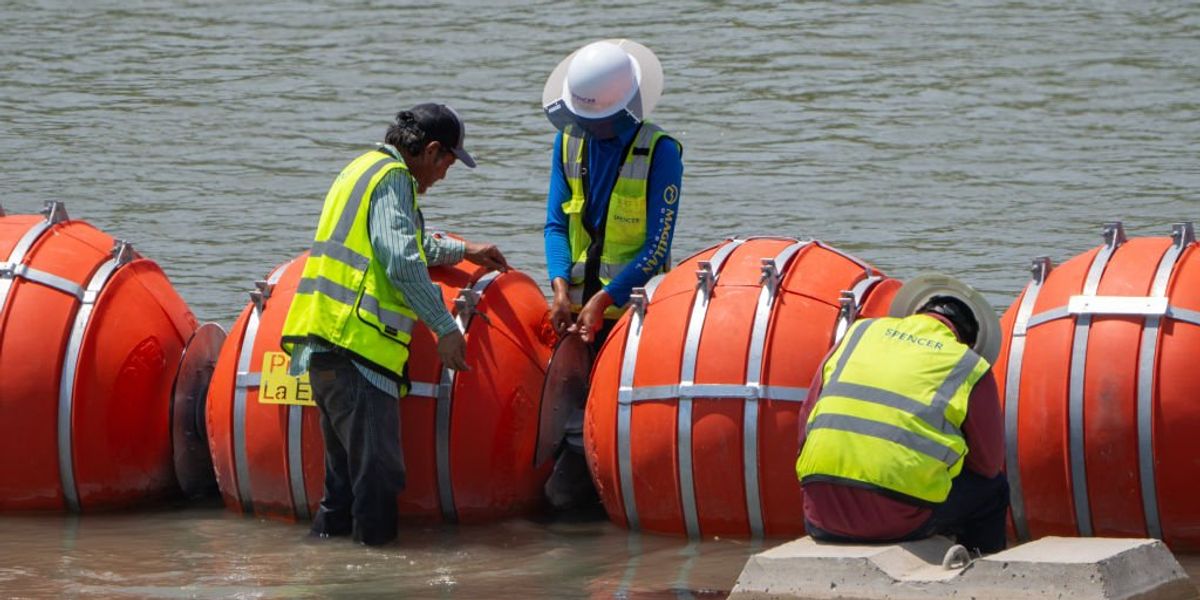President Donald Trump’s administration is taking a firm stance to address the ongoing issue of illegal crossings from Mexico by planning to install floating buoy barriers along the Rio Grande. The Washington Examiner highlighted that this initiative involves a substantial 17-mile-long buoy wall in Texas’s Rio Grande Valley. Texas Governor Greg Abbott, responding to the crisis under former President Joe Biden’s tenure in 2023, had already implemented a similar measure with great success.
Governor Abbott’s version of the buoy barriers was designed to tackle the illegal immigration crisis, especially in the bustling Eagle Pass area. These buoys, interconnected and inflatable, were four feet wide and acted as a rotating fence to deter illegal aliens from climbing over. This innovative approach marked the first deployment of such a deterrent along the U.S.-Mexico border, although it wasn’t without controversy.
The Biden administration’s Department of Justice challenged Abbott’s buoy barrier, arguing that Texas failed to obtain the necessary federal authorization. The lawsuit also raised environmental and safety concerns associated with the barrier. However, the Trump administration is expected to dismiss this case against Texas, supporting the state’s efforts to secure the border.
The idea of floating barriers was initially developed during Trump’s first administration by the Border Patrol. However, the concept wasn’t realized until after the administration change. After former Border Patrol agent Mike Banks became Texas’s border czar, the state independently moved forward with the plan.
Mike Banks, now the national Border Patrol chief, was instrumental in rolling out this strategy in Texas. According to the Washington Examiner, Texas is keen to offer its 1,000-foot barrier as a gift to the Trump administration. This gesture signifies the state’s commitment to border security and its collaboration with federal efforts.
Selene Rodriguez from the Texas Public Policy Foundation expressed confidence in the buoy wall’s effectiveness in curbing illegal crossings. Rodriguez emphasized that Texas had to devise its own solutions to protect the border and support law enforcement. The buoy barrier was a crucial measure, and its success is now being recognized by the Trump administration.
Border czar Tom Homan praised the floating wall, describing it as “a great border barrier concept.” He noted that the Border Patrol had been considering their use towards the end of Trump’s first term and viewed them as a valuable tool for securing the border and saving lives. The buoy barriers were not deployed initially due to the change in administration.
Governor Abbott’s swift deployment of the buoys demonstrated their effectiveness, reinforcing the idea that border barriers like walls and buoys do indeed work. The data collected supports this assertion, providing evidence of their impact on reducing illegal crossings. The implementation of these barriers reflects a proactive approach to border security.
The Washington Examiner’s report underscores the importance of innovative solutions in addressing the nation’s illegal immigration crisis. As Texas continues to lead the way, the Trump administration’s willingness to adopt similar measures highlights the shared commitment to securing the border. The buoy barriers represent a practical and effective method of deterrence.
This approach aligns with the political ideology held by influential conservative figures like President Ronald Reagan and Barry Goldwater. It prioritizes national security and the rule of law, principles that resonate deeply with conservative values. The Trump administration’s focus on border security is consistent with these ideals.
By supporting Texas’s actions, the Trump administration is reinforcing the importance of state and federal collaboration in tackling immigration challenges. The buoy barriers symbolize this partnership and the shared goal of protecting the nation’s borders. This strategy exemplifies a return to strong, conservative leadership.
The decision to deploy floating buoy barriers demonstrates a commitment to practical solutions in addressing illegal immigration. It reflects a broader strategy of utilizing innovative methods to achieve border security. The success of Texas’s initiative serves as a model for future efforts.
As the Trump administration moves forward with this plan, it underscores the importance of decisive action in securing the border. The buoy barriers are a testament to the power of innovative thinking in solving complex problems. This approach is a significant step in addressing the ongoing immigration crisis.
The collaboration between Texas and the Trump administration highlights a shared commitment to national security. By working together, they are demonstrating the effectiveness of state-led initiatives in achieving federal objectives. This partnership serves as a blueprint for future border security efforts.
The buoy barriers represent a practical and effective solution to the challenges of illegal immigration. They offer a tangible way to enforce border security and uphold the rule of law. This approach aligns with conservative values and the principles of strong governance.
The Trump administration’s embrace of Texas’s buoy barrier initiative signals a commitment to robust border security measures. It reflects a strategic approach to addressing immigration challenges. This partnership underscores the importance of innovative solutions in protecting the nation’s borders.
By adopting Texas’s buoy barrier strategy, the Trump administration is taking a proactive stance on border security. This approach exemplifies the principles of conservative leadership and effective governance. It demonstrates a commitment to safeguarding the nation’s borders through practical solutions.



